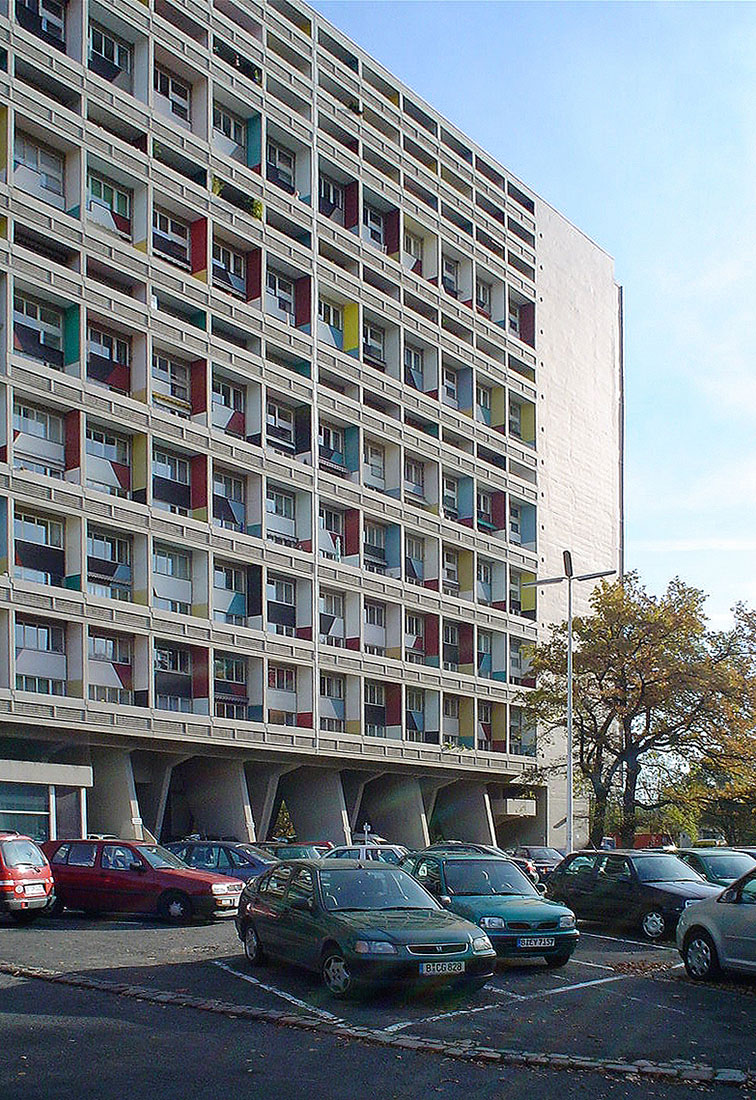 |
 |
 |
 |


Unité d'Habitation
Flatowallee 16, Berlin
1956 - 1958
Le Corbusier has reworked his "Unité d'Habitation" high-rise typology for the International Building Exhibition of 1957, the so-called Interbau 57. Originally the building, called Unité d'Habitation type Berlin, was intended to be realized in the Hansaviertel, where the exhibition actually took place. The layout of the Hansaviertel is understood as a reaction to the architecture of East Berlin. The design by Le Corbusier was not built at the planned location because of its size. An urban site between the Berlin Olympiastadion and the Heerstrasse, in the so-called "Heilsberger triangle" between today's Flatowalle and the S-Bahn route, was provided by the city of Berlin. On the parcel with a size of about 6.3 ha, a natural landscape was designed, the building is shielded by a forest belt. The house, which was built between 1957 and 1958 is located on a hill, which slightly surpasses the environment. Remarkable was the short construction period of only 18 months, which could be achieved by means of a field factory. The Unité d'Habitation type Berlin has a total of 530 apartments on 17 floors. Ten "rue interieurs" were created as accesses to these apartments. The building reaches an height of 53 meters and is 141 meters long. The horizontal ribbons of colored loggias are arranged around the façade and are visible from far away. Due to the German building laws and the rules for social housing, the building largely differs from the original design. For example, the distinctive columns under the building were not realized in plastic forms but in simple cross-sections appearing as slabs. Likewise, some dimensions deviate from the proportioning scheme of the Modulor, so that the intended room height of 2.26 m was changed and a room height of 2.50 m was realized. Although Le Corbusier had accepted the deviations in 1957, he later dissociated himself from the realized building. The building, which has been designated as Corbusierhaus, is a protected monument since 1996. Overall, Le Corbusier has planned and built 5 Unités, based on the experience of the first Unité in Marseille, which is considered as a prototype.
Für die Internationale Bauaustellung von 1957, die sogenannte Interbau, hat Le Corbusier seinen Hochhaustyp "Unité d'Habitation" überarbeitet. Ursprünglich sollte das Gebäude, bezeichnet als Unité d’Habitation type Berlin, im Hansaviertel realisiert werden, wo die eigentliche Interbau stattfand. Das Hansaviertel wird als Reaktion auf die Architektur Ost-Berlins verstanden, und der Entwurf von Le Corbusier wurde schlussendlich aufgrund seiner Grösse nicht am geplanten Standort errichtet. Ein städtisches Grundstück zwischen dem Berliner Olympiastadion der der Heerstrasse, im sogenannten "Heilsberger Dreieck" zwischen der heutigen Flatowalle und der S-Bahn Trasse, wurde von der Stadt Berlin zur Verfügung gestellt. Auf dem Grundstöck von ca. 6.3 ha Grösse, wurde ein naturnaher Landschaftsraum gestaltet, wobei das Gebäude von einem Waldgürtel abgeschirmt wird. Das Wohnhaus, welches zwischen 1957 und 1958 gebaut wurde befindet sich auf einer Anhöhe, welche die Umgebung leicht überragt. Bemerkenswert ist die kurze Bauzeit von nur 18 Monaten, welche mittels einer Feldfabrik erreicht werden konnte. Die Unité d'Habitation type Berlin hat insgesamt 530 Wohnungen auf 17 Stockwerkern. Für die Erschliessung dieser Wohnungen wurden zehn "rue interieurs" angelegt. Das Gebäude erreicht eine Höhe von 53 Metern und ist 141 Meter Lang. Die horizontalen Bänder der farbig gestalteten Loggien gliedern die Fassade und sind weithin sichtbar. Aufgrund der deutschen Baugesetze und der Vorschriften für den sozialen Wohnungsbau weicht das realisierte Gebäude relativ stark vom ursprünglichen Entwurf ab. So wurden zum Beispiel die markanten Stützen unter dem Baukörper nicht in plastischer Form sondern in einfachem Querschnitt als Scheiben realisiert. Ebenso weichen einige Abmessungen vom Proportionsschema des Modulor ab, so dass anstelle der vorgesehenen 2.26 m eine Raumhöhe von 2.50 m realisiert wurde. Obwohl Le Corbusier im Jahr 1957 die Abweichungen akzeptiert hatte, distanzierte er sich später vom ausgeführten Bau. Das als Corbusierhaus bezeichnete Gebäude steht seit 1996 unter Denkmalschutz. Insgesamt hat Le Corbusier 5 Unités geplant und gebaut, basierend auf den Erfahrunge der ersten Unité in Marseille, welche als Prototyp gilt.